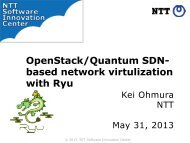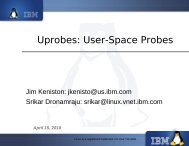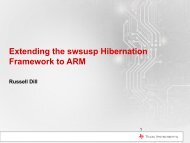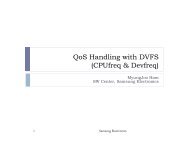Platform-based Power Management and Linux - The Linux Foundation
Platform-based Power Management and Linux - The Linux Foundation
Platform-based Power Management and Linux - The Linux Foundation
You also want an ePaper? Increase the reach of your titles
YUMPU automatically turns print PDFs into web optimized ePapers that Google loves.
<strong>Platform</strong>-<strong>based</strong> <strong>Power</strong><br />
<strong>Management</strong> <strong>and</strong> <strong>Linux</strong><br />
Bdale Garbee, HP<br />
Naga Chumbalkar, HP<br />
© Copyright 2010 Hewlett-Packard Development Company, L.P.
“<strong>Power</strong> saved is power<br />
generated”<br />
Anonymous<br />
2<br />
© Copyright 2010 Hewlett-Packard Development Company, L.P.
Agenda<br />
• More upstream, less maintenance<br />
• BIOS-<strong>based</strong> P-state management<br />
• <strong>Platform</strong>-<strong>based</strong> <strong>Power</strong> Capping<br />
• Processor Clocking Control (PCC) interface<br />
• Collaboration between OS <strong>and</strong> platform<br />
3 4 May 2010
More upstream, less maintenance<br />
• Previously closed-source drivers are now<br />
upstream<br />
• hpilo : Channel interface driver to<br />
communicate with the management processor<br />
• hpwdt : Watchdog timer. Also sources NMIs to<br />
inform user what HW component is at fault<br />
4 4 May 2010
Typical Server <strong>Power</strong> Usage
Managing P-states<br />
P-State Technology<br />
HP ProLiant<br />
Intel Enhanced SpeedStep DL380 G6<br />
AMD <strong>Power</strong>Now! DL585 G6<br />
Intel Xeon X5570 Processor<br />
P-State<br />
Frequency<br />
P0<br />
2.92 GHz<br />
P1<br />
2.79 GHz<br />
P2<br />
P3<br />
2.66 GHz<br />
2.53 GHz<br />
<strong>Linux</strong><br />
<strong>Platform</strong><br />
P4<br />
P5<br />
P6<br />
2.39 GHz<br />
2.26 GHz<br />
2.13 GHz<br />
OS<br />
Driver<br />
System ROM<br />
P7<br />
P8<br />
2.00 GHz<br />
1.86 GHz<br />
HW Registers<br />
HW Registers<br />
P9<br />
1.73 GHz<br />
P10<br />
1.60 GHz
<strong>Power</strong> Capping<br />
• Limit the power a server can use<br />
• Implemented in the firmware, hardware<br />
• Independent of the OS<br />
Data center advantages:<br />
• Aids in provisioning cooling infrastructure<br />
• Protects electrical circuit-breaker from tripping<br />
• Reclaims trapped power (example on another<br />
slide)
<strong>Power</strong> vs. Performance
<strong>Power</strong> Capping - Example<br />
HP ProLiant<br />
DL380 G5<br />
Faceplate<br />
“capped”<br />
Total <strong>Power</strong><br />
Consumed<br />
6 400 W 2400 W<br />
6 300 W 1800 W<br />
8 300 W 2400 W<br />
<strong>Platform</strong> guarantees that the power will be “capped” at 300W per server<br />
Reclaim trapped power, <strong>and</strong> allocate two more servers!
OS vs. <strong>Platform</strong><br />
OS<br />
Kernel<br />
Single-server<br />
centric<br />
Server-level<br />
capping<br />
<strong>Platform</strong><br />
System ROM, BMC/Enclosure FW<br />
Enclosure-level view<br />
Group-level power capping
Processor Clocking Control (PCC)<br />
• Interface between BIOS <strong>and</strong> OS<br />
• Feedback to the OS to become “capping” aware<br />
<strong>Linux</strong> with PCC support<br />
OS<br />
PCC Driver<br />
System ROM<br />
HW Registers
Interaction between <strong>Linux</strong> <strong>and</strong> platform<br />
<strong>Linux</strong><br />
PCC<br />
BIOS<br />
Set P-state<br />
CPU<br />
CPU frequency telemetry<br />
BMC<br />
(iLO2)<br />
<strong>Power</strong> cap<br />
HW<br />
Group power cap<br />
<strong>Power</strong> usage<br />
12 4 May 2010
PCC usage<br />
• PCC consists of a shared memory region that can<br />
be accessed by OS <strong>and</strong> BIOS<br />
• OS computes required target frequency for a<br />
logical CPU <strong>based</strong> on workload<br />
• PCC driver sends comm<strong>and</strong>s to the BIOS via<br />
input/output buffers to honor the OS’s request<br />
• <strong>Platform</strong> will achieve that frequency. However, if<br />
power budget conditions are in place, platform will<br />
achieve the best possible frequency
PCC discovery<br />
• BIOS will expose PCC only if OS is capable<br />
• OS can evaluate ACPI PCCH() to discover shared<br />
memory area location<br />
• OS can evaluate ACPI PCCP() to discover<br />
input/output buffer location for each logical CPU
Shared Memory Region<br />
discovered via PCCH ()<br />
$ PCC<br />
signature<br />
discovered via PCCP ()<br />
input buffer<br />
logical CPU0<br />
output buffer<br />
logical CPU0<br />
input buffer<br />
logical CPU1<br />
output buffer<br />
logical CPU1<br />
15 4 May 2010
PCC Comm<strong>and</strong>s<br />
• Get Average Frequency<br />
• Set Desired Frequency<br />
Get freq<br />
OS<br />
Governor<br />
PCC driver<br />
Set freq<br />
<strong>Platform</strong><br />
firmware<br />
Processor
PCC is not proprietary<br />
<strong>The</strong> Processor Clocking Control (PCC) Specification is open:<br />
http://www.acpica.org/download/Processor-Clocking-Control-v1p0.pdf<br />
PCC driver is open source, <strong>and</strong> is upstream (2.6.34)<br />
http://git.kernel.org/?p=linux/kernel/git/torvalds/linux-2.6.git;a=blob;f=arch/x86/kernel/cpu/cpufreq/pcccpufreq.c;h=ce7cde713e7174e8293b552b332f968946a46904;hb=250541fca717a5c9b0d3710e737b2ca32eb<br />
b6fbc<br />
Driver is not tied to any specific platform vendor<br />
Driver will load on any platform that supports the<br />
PCC specification
Collaborate <strong>and</strong> Innovate<br />
PCC allows the platform to innovate<br />
(e.g.) power capping, enclosure-level group capping<br />
Allows the OS to innovate<br />
(e.g.) better methods to react to changing workload,<br />
decide what CPU on what NUMA should be at what speed<br />
No one entity (platform, OS) has a complete picture of the<br />
individual server <strong>and</strong> the data center.
Outcomes that matter.

















